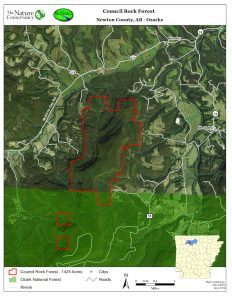The Nature Conservancy buys large land tract in Buffalo River watershed
by December 6, 2016 4:05 pm 877 views

More than 1,400 acres of land in Newton County and within the Buffalo River watershed will be placed in conservation thanks to the family of a doctor from Michigan who traveled Arkansas in the 1950s as a public health physician.
The Nature Conservancy in Arkansas (TNC), a nonprofit organization that works to protect natural habitats and wildlife in Arkansas, recently paid $700,000 for 1,425 forested acres on a mountain west of Mount Judea along Big Creek, which flows into the Buffalo River. The “Council Rock Forest” preserve is the culmination of years of property acquisition by Dr. Johan and Frances Eliot.
TNC officials are working with the Buffalo River Foundation to raise money for conservation efforts with the newly acquired property. The Eliot’s children have worked with the TNC to preserve the property in accordance with their parents’ wishes.
“This conservation acquisition is a great example of landowners in the Buffalo River watershed working in practical ways to conserve the natural resources and cultural heritage of the Buffalo River watershed,” Mike Mills, Buffalo River Foundation board member, said in a statement announcing the land deal.
Designated in 1972 by President Richard Nixon as America’s first national river, the Buffalo National River travels freely for 135 miles and is one of the few remaining undammed rivers in the lower 48 states. Legislation creating the national river area was pushed by the late U.S. Rep. John Paul Hammerschmidt, R-Harrison. A popular camping, canoeing and fishing destination, the Buffalo National River attracts more than 1 million visitors a year.
The river watershed is home to more than 300 species of fish, insects, freshwater mussels and aquatic plants, including the endangered snuffbox mussel. The Council Rock Forest is home to three rare bat species — the northern long-eared bat, Indiana bat, and gray bat — according to the TNC.
 “Council Rock Forest has been a special place for people for generations,” said Scott Simon, director of The Nature Conservancy in Arkansas. “We are honored to be a part of its history and look forward to working with our neighbors and other organizations on the future of this great place.”
“Council Rock Forest has been a special place for people for generations,” said Scott Simon, director of The Nature Conservancy in Arkansas. “We are honored to be a part of its history and look forward to working with our neighbors and other organizations on the future of this great place.”
Also according to the TNC statement, Council Rock Forest includes a log home built by Peter Campbell in the early 1900s.
“Many residents of the valley below the mountain descend from Mr. Campbell including his youngest son, Loyd, who was born in the cabin in 1938 and still lives nearby. Neighbors remember the Eliots fondly for restoring the homestead and allowing it to be a place to gather, learn, and enjoy,” noted the TNC.
Simon told the Northwest Arkansas Business Journal that the family approached TNC 10 years ago to learn how the process would work. The family recently made the decision to sell the land at a deep discount so it could be placed in conservancy.
“The family has made an incredible gift to Arkansas. They wanted to follow through on their father’s wishes … and we want to continue to manage the property in the style that the Eliot’s used it,” Simon said.
He said the group will spend the next year learning “from the neighbors, community leaders” and other stakeholders about how best to manage the property. Simon said “the best conservation plan, the best land management plan to conserve the features of the property, and a use plan that is a benefit to the community” will come from the process. Examples of uses for other property managed by TNC include bike trails built by volunteers in the Smith Creek Preserve in Boxley Valley and offroad bike trails near the Kings River. The Council Rock Forest terrain could support rock climbing.
“If the rock is good for climbing, and the neighbors support it, that would be a possibility,” Simon explained, adding that with each idea “we have to figure out how to pay for it … and how it’s managed.”
The move to place the large tract of land was in motion well before the ongoing controversy related to a nearby large hog farm. C&H Hog Farm is located near Big Creek and has the capacity to house 6,500 swine.
Arkansas officials approved permits for the farm in late 2012. Several environmental groups unsuccessfully attempted to block farm construction, claiming waste runoff from the farm would result in harmful pollution of the Buffalo River.
In August 2015, and after the C&H farm was built, the Arkansas Pollution Control and Ecology Commission placed a five-year ban on large hog farms in the Buffalo River Watershed.
